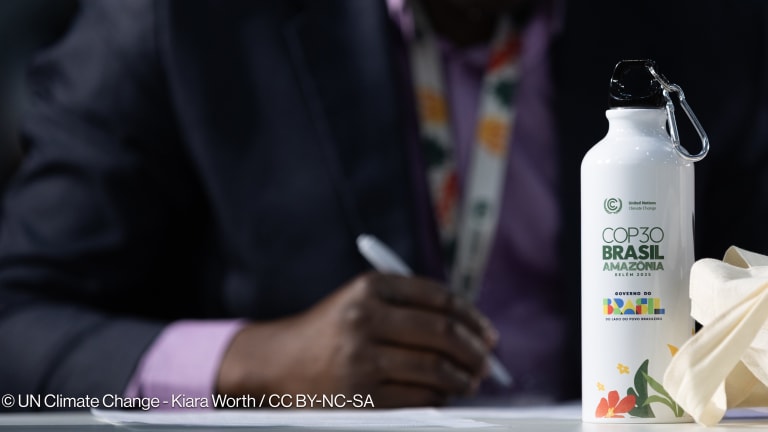
CANBERRA — Over the past decade, almost 4000 natural disasters have impacted 2 billion people costing $1.7 billion in damages. Two-thirds of those affected were found in China, India, and the Philippines. But the demand for support is shifting, the 2018 “World Disasters Report,” released by the International Federation of the Red Cross, has found.
Some 134 million people needed humanitarian assistance in 2018, the report shows, quoting United Nations data. IFRC emergency operation budgets have seen an increased demand to support biological disasters, populations movements, and weather-related disasters.
As IFRC and governments worldwide are looking to the 2030 Agenda for Sustainable Development and the SDGs, including efforts to “leave no one behind,” the report serves as a resource that IFRC will use to advocate for change both internally and externally.
Dr. Jemilah Mahmood, under-secretary-general at IFRC, spoke to Devex while she was in Australia following the launch of the report, on the message IFRC wants to covey and how it will impact internal and external advocacy.
Creating the report’s message
“If we are going to look at leaving no one behind in achieving the SDGs, we are not going to achieve this if we don’t look at the humanitarian context,” Mahmood explained to Devex.
Mahmood said that IFRC wanted to know who was getting left behind in humanitarian disasters, and to do so, drew on the resources of its 190 national societies.
“We collected their thoughts and found that there are five pathways to leaving people behind — what we call ‘fatal flaws’. They are people that are out of sight, out of reach, out of the loop, out of scope and out of money,” Mahmood said.
An important part of the message to get out, Mahmood said, is that money alone does not lead to inclusion. What is required is to consciously recognize and address this gap, and identify the people that humanitarian responses need to be better engage with — which means a change in approach.
“Organizations should not just be where it is easy,” she said.
Advocating through the disasters report
“Our pledge, as a federation, is to make [the] last mile the first mile and systematically look out for those that are hardest to reach,” Mahmood explained. “It also calls for us, in that process, to look out for people we may not often always see — including the elderly and people with disability.”
The report enables IFRC to make recommendations to the governments of affected countries, to donors and to international actors — including the U.N. — in making commitments.
While in Australia, Mahmood met with the Department of Foreign Affairs and Trade, using the report to highlight the importance of disaster resilience funding, providing them “food for thought.”
Kerala's unique plan for the next disaster: Train the kids
The state's worst monsoon in a century devastated lives, homes, and the economy. With an eye to worsening natural disasters, the government, aided by several nonprofits, is focused on a sweeping curriculum update.
“We feel very excited as we have started working on forecast [supporting] base finance using science and technology to match with early warning systems in communities, and triggering finance even before an event happens,” Mahmood explained. “The impact on communities is reduced, and there is already evidence showing that the cost-benefit is high.”
Whatever the ongoing dialogue with humanitarian actors — about leaving no one behind, climate change, or the “grand bargain” — the report makes a case that supporting local action and community participation is a key pathway.
Strategies to support reaching the missing
As the report was being finalized, the earthquake and tsunami struck Palu, Indonesia — for Mahmood, a disaster that underscored the need for humanitarian responders to better reach the missing millions.
“Times have changed and governments like Indonesia want to take charge,” Mahmood said.
Localization is an important focus of IFRC and its national societies. Importantly, she explained, localization could address key factors that saw people getting left behind — lack of community, cultural, and language knowledge.
“If you truly want to leave no one behind, this requires better engagement and participation at the community level,” Mahmood said. “The evidence we are collecting is that even when people are reaching them, they don’t understand the context, and the people being supported don’t understand what they are trying to offer. We often bypass local communities and assume they don’t know anything — but the knowledge is there.”
“Missing maps,” or lack of geospatial detail on communities in the developed world, is noted in the report as an important area to be improved to better support and respond to communities following a disaster.
Affected communities are commonly mapped following a disaster rather than before. But with community-based mapping a tool that has been supporting the improvement of geospatial data for over a decade, there is no excuse for not being proactive in mapping the developing world.
“After the 2010 Haiti earthquake, external experts tried to using sophisticated mapping techniques to map the area,” Mahmood said. “But they did not speak to local people. They could tell you where people lived, where the school was, where the church was. They know where things are in their community.”
It requires engagement with communities and prioritizing their voices — a key message IFRC will be communicating.








